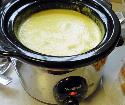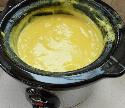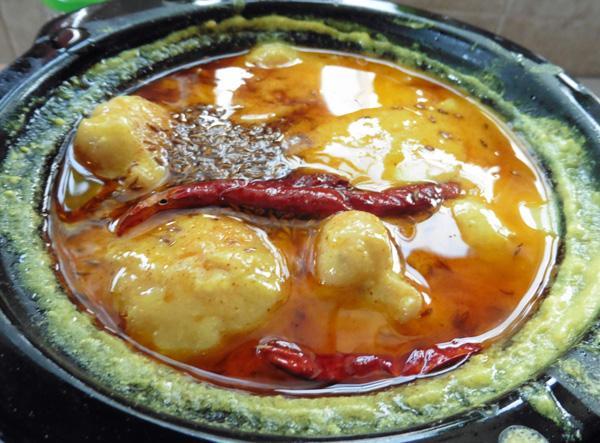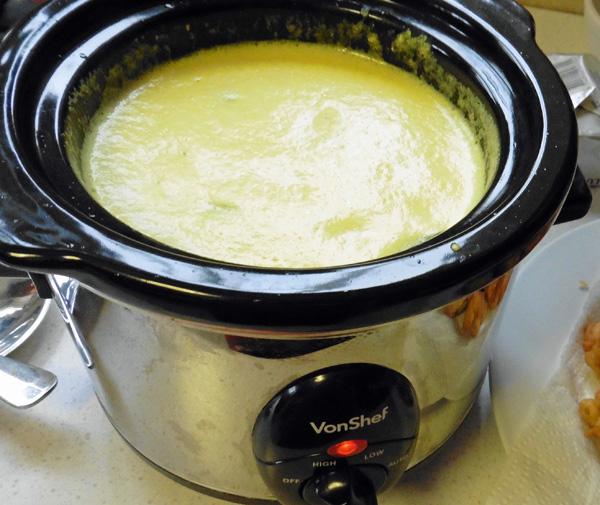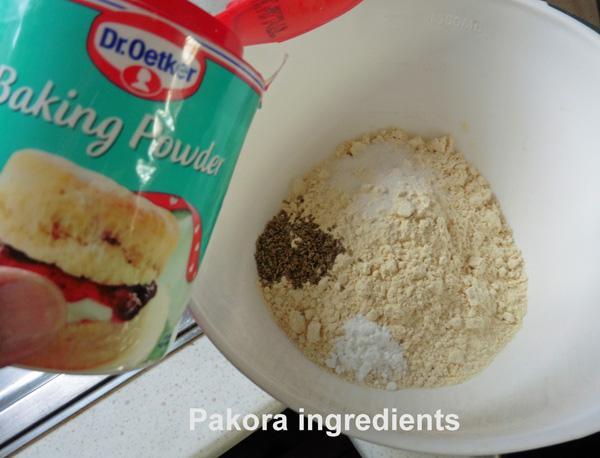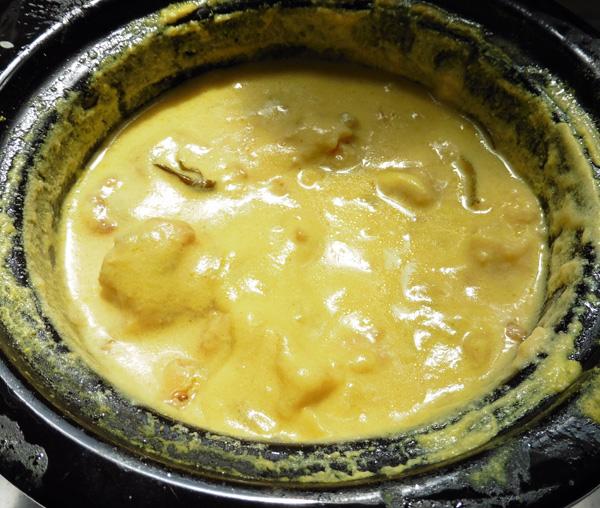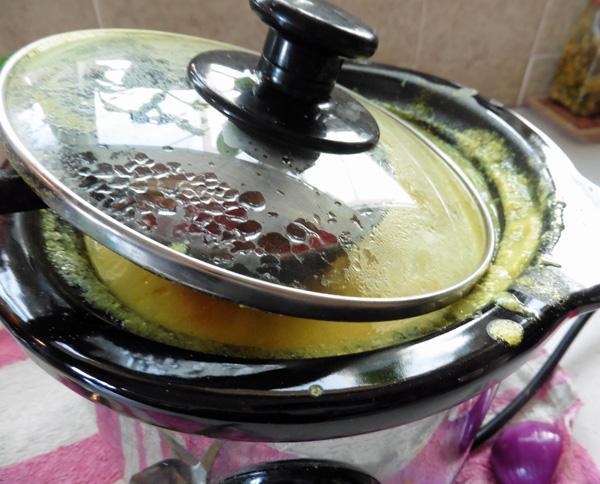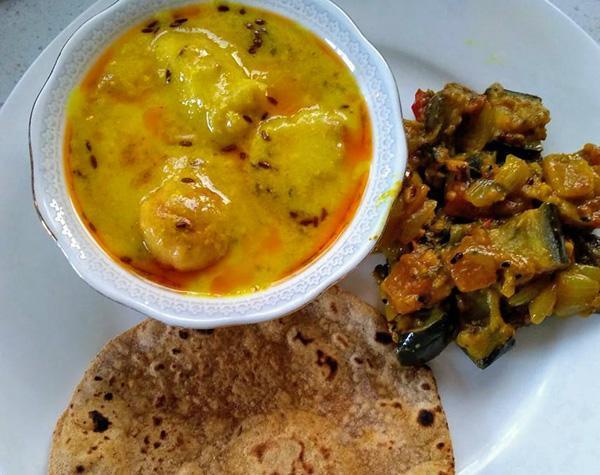Kadhi 2 - North Indian, Cooked In a Slow Cooker
North Indian Kadhi Cooked in Slow Cooker
Mamta Gupt
Kadhi is a North Indian dish that needs no introduction, at least in north India. Everyone knows it well, most love it, including children. It is cooked regularly in most houses, mostly served with Boiled Rice. Unfortunately, it is one of those dishes that is not widely available in Indian restaurants in UK, more is the pity! In North India, it is a must at one of the meals in the days preceding a wedding.
North Indian kadhi is thicker than Gujarati Kadhi, the consistency of custard sauce. It also has dumplings or pakoras in it, unlike Gujarati Kadhi. You can add vegetables to the kadhi sauce while it is cooking, things like chopped spinach (palak) or fenugreek (methi) leaves. Experiment with diced potatoes, carrots or any other vegetable of choice. I often add chopped onions and green chillies to my Pakora/dumpling batter.
The recipe may look long, but it is an easy dish to make. Serves 4-6
Edited June 2020
Ingredients
For the Kadhi Sauce:
500 gm. or approximately 2 cups extra-mature or 'khatta' natural yoghurt (you can use mature butter milk/maththa instead)
4 tbsp. gram flour or besan
1 1/2 tsp. salt, adjust to taste
1/2 tsp. turmeric powder
1 litre or approximately 4 cups water
1 tbsp. cooking oil
1/2 tsp. fenugreek or methi seeds (too many will make kadhi bitter)
A pinch of asafoetida or hing powder
12-15 curry leaves or Kadhi patta
For the Dumplings or Pakoras:
2 cup gram flour or besan, sifted to remove lumps
1/4 tsp. salt
1/2 tsp. baking powder
Water to make batter
2 cups oil for deep frying
Optional additions to Dumpling or Pakora batter:
1 sliced or chopped onion and/or 1 small potato, chopped finely or 1-2 tabs. dry fenugreek leaves (Kasoori methi) or grated vegetables like courgettes or carrots.
Also see Also see Microwave Pakore in Notes.
For Tempering or Tarka:
1 1/2 tbsp. ghee or oil
1 tsp. cumin seeds
A few curry leaves 10-12
A large pinch of asafoetida or hing powder
4-5 small, dry red chillies or 2 chillies roughly broken up
1/2 tsp. chilli powder
Instructions
Making Kadhi Sauce
Place yogurt and sifted besan flour in a bowl, along with salt, chilli, turmeric and water. Beat together to make a smooth, thin batter.
Transfer to a slow cooker and switch on high.
Heat oil in a ladle, add fenugreek seeds, asafoetida powder and curry leaves. As soon as fenugreek seeds begin to turn brown (do not let the seeds turn dark brown or black, they turn bitter), pour over the yoghurt-besan mix in the slow-cooker, closing the lid for flavours to infuse.
Let the kadhi cook for a few hours until it is custard like consistency. If it is too thin, you can add a little more besan four beaten/mixed in water half way through.
Add pakoras, turn the cooker off or down to slow to keep it warm. Do not cook after adding pakora dumplings, they are likely to breakup.
Making Pakoras or dumplings: While the Kadhi is cooking by your chosen method, make the dumplings as follows.
Place all Pakora ingredients for dumplings in a bowl and make a batter of dropping consistency, with enough water. Beat it well. The trapped air is what will make them light and fluffy. Solid dumplings do not taste nice. My mum used to make pakoras without the addition of baking powder. She beat the batter by hand, until a drop of it dropped in a glass of water floated to the top, instead of sinking down. I use electric beater, much faster!
Heat oil to a medium heat (not smoking hot), in a wok or karahi. When right temperature is reached, a drop of batter dropped in the oil should sizzle up to the top quickly.
Drop dollops of the batter into the hot oil, either with a dessert spoon or with your fingers. Do this gently, from the side of the wok. This stops the oil from splashing on to your hands/face. Make as many at a time as can float without overlapping each other.
Fry until golden brown. Keep aside. (I make extra as my family always eats quite a few while I am frying them.
Tempering or Tarka: Before serving, heat the kadhi and place in a serving bowl.
Heat the ghee in a large ladle or a small pan.
Add cumin seeds and asafoetida. Once the seed splutter, add whole chillies, chilli powder and stir quickly with a spoon.
Pour it over the kadhi.
Cover with a lid immediately. This will allow the flavours to infuse.
Serve with Boiled Rice.
Also see Kadhi Soup and Gujarati Kadhi.
Notes
You can omit dumplings altogether if you wish, and add vegetables like boiled and dices potatoes, sliced onions, 7-8 spinach leaves or a handful of fenugreek/methi leaves.
Drumsticks (see last picture), if available, can also be added to the Kadhi sauce while it is cooking. Cut into 4-5 inch pieces.
You can use Boondis, instead of pakoras.
Microwave pakoras/dumplings are low fat and can be cooked almost fat free, without frying. Place all dumpling ingredients in a bowl + 1 teaspoon oil and make quite stiff batter. Place about 8 dollops of this batter on a microwave steamer plate. Steam at around 800 power, for 2 minutes. Adjust time for different powers. My elder brother Ashok taught me this method. He says, “the reason why you have to add a little oil to the batter is that fat in the batter heats up preferentially, faster than the rest of the material. This helps to cook the entire core uniformly. It is a known scientific fact that the electro-magnetic waves produced in a microwave oven are preferentially absorbed by good conductors of electricity and by certain long chain molecules of food, like in fat, egg yolk, sugar and even water which is a better conductor of electricity than flour. This is the reason why when you try to roast peanuts or almonds in a microwave, you may be able to handle them with naked fingers, but try putting them in your mouth, you will almost surely scald your tongue! Similar thing happens when you warm samosas or patties in a microwave when the filling gets heated much more than the skin.


